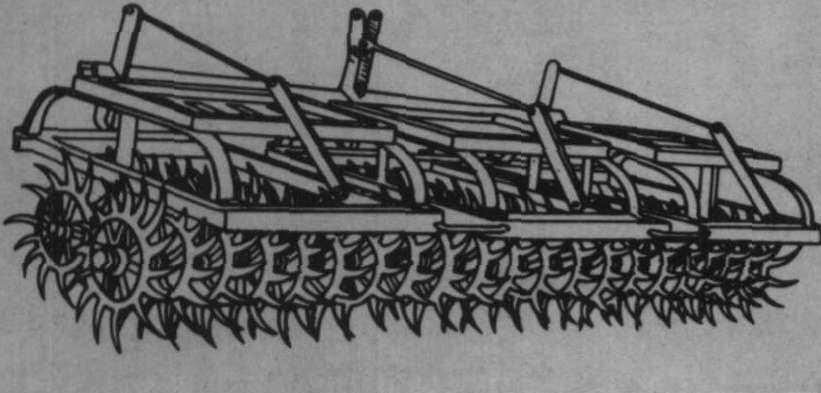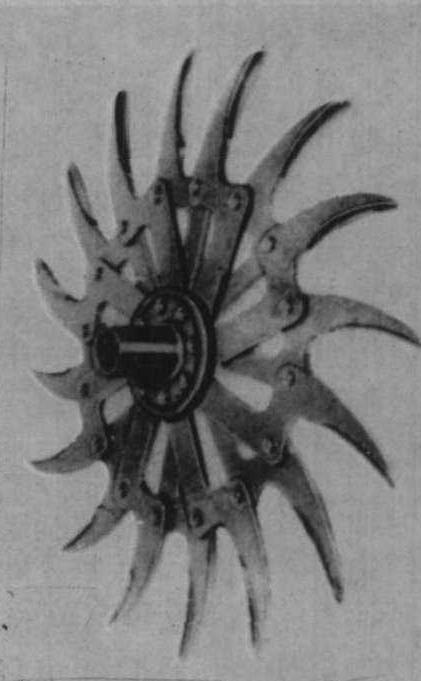除草机械weeding machinery
用于夏季休闲地除草、播前整地除草与出苗前后松土除草的机械。早期的除草作业完全依靠人力。20世纪30年代机力除草机械开始应用于生产。50年代世界各国普遍使用化学除草剂,减少了机械除草的作业量。但是,除草机械在除草同时还有松土作用,使土壤保墒和通气; 休闲地除草后,杂草覆盖在地表上,可减少水土流失。因此仍为各国采用。
除草机械的作业深度较浅,工作阻力较小。其工作部件型式有锄铲式、杆式和齿盘式等。与大型拖拉机配套的除草机械幅宽大,采用两侧绞接的机架,以适应地形。运输时可用液力折叠。
锄铲式除草机 以除草铲为主要工作部件的除草机械。除草铲有单翼铲、双翼铲和宽平铲三类。单翼铲主要用于行间中耕。图1所示锄铲式除草机由双翼铲翼平面与地平面的夹角为碎土角,起疏松土壤作用。铲脊线与地平面的夹角为安装角,影响作业深度和切土阻力。由于工作参数不同,双翼铲又可分为双翼除草铲和双翼通用铲。双翼除草铲的碎土角(12°~18°)与安装角(6°~10°)都很小,除草作用强,松土作用弱。双翼通用铲有较大的碎土角(25°~30°)和安装角(14°~18°),兼有除草和松土作用。除草铲的铲柄有刚性铲柄和弹性铲柄两种。弹性铲柄作业时有振动作用,效果较好。有的刚性铲柄带有弹簧安全器。机架一般由2或3根横梁组成,铲柄固定在横梁上。双翼铲前后交错配置,配置锄铲时应防止堵塞与漏锄。机架的前面或中间装有轮子,通过螺杆机构或液压缸改变轮子的高度位置,即可调节锄铲的工作深度。宽平铲式除草机作业宽度可达1.8米,主要用于休闲地除草,也可用于不翻土的浅耕。工作时平铲(图2)切断草根,疏松土壤并把残茬留在地表。机架上一般安装3个宽平铲,前后交错配置。铲柄正前方装有圆犁刀,切断残茬,防止杂草在铲柄前拖堆。工作部件的升降及工作深度的调节均由液力操纵轮子来实现。作业深度一般为8~15厘米。

图1 锄铲式除草机
铲、机架、悬挂装置等部分组成。双翼铲由双翼铲头与铲柄组成。双翼铲头的两铲刃间的夹角称为翼张角,常在60°到90°之间。锄铲工作时,草根被刃口切断。

图2 宽平铲式除草铲
杆式除草机 以横向水平放置的旋转钢杆(除草杆)为工作部件的除草机。用于播前整地和休闲地除草。除草杆的断面为方形、六角形或圆形。它通过几个轴承固定在支架的托板上,由地轮或拖拉机动力输出轴驱动,转动方向与地轮相反。除草时,除草杆在地表下4~7厘米处通过,转动的除草杆可破坏草根和土壤的结合,使杂草迅速枯萎,且不易缠草;还可疏松表土并将下层土壤压实,达到保墒的目的。当地表比较坚实时,在除草杆前方加设松土铲,帮助除草杆入土。作业深度由限深轮高度控制。除草杆的单组幅宽可达3.6米。宽幅机型由2~5组除草杆组成。
转动锄 以齿盘为工作部件,作业时因土壤阻力而转动的除草机械(图3)。用于种子出苗前后的松土除草。疏松土层深度为3~5厘米,可消灭浅根杂草。齿盘型式有多种,图4所示是用得较广的一种。锄齿装在幅盘上,损坏后可拆下更换。弯齿破碎土壤板结层的硬壳,消灭幼草。齿盘一般排成二行,前后齿盘交错配置。分组与机架联结,在不平整的地面上可获得较一致的耕深。转动锄的作业速度高达16千米/小时。有的机型在拖拉机正后方机架上固定一个钢丝网,阻挡抛起的土块。

图3 转动锄

图4 转动齿盘